the place where Paleontology and Paleoanthropology meets Philately
The Discovery of the Woolly Mammoth
Content
Introduction
When we say “mammoth,” we usually mean the woolly mammoth (Mammuthus primigenius) — the best-known and last surviving member of the mammoth family.Mammoth, (genus Mammuthus), any member of an extinct group of elephants found as fossils in
Pleistocene deposits (2.6 million years ago - 11,700 years ago), over every continent except
Australia and South America and in early Holocene [11,700 years ago till present] deposits of North America.
The woolly, Northern, or Siberian mammoth (Mammuthus primigenius)
is by far the best-known of all mammoths.
ENCYCLOPADIA BRITANNICA
 |
| One of the earliest postage stamps featuring the woolly mammoth (Mammuthus primigenius) was issued by Mongolia in 1967 (MiNr: 467, Scott: 454). The stamp reflects the scientific understanding of the time, portraying the mammoth with disproportionately large ears and long tail, resembling those of an African elephant, and set against a backdrop of ice and snow. This reconstruction is now considered outdated, as modern research has shown that woolly mammoths had much smaller ears, shorter tails and other adaptations to reduce heat loss in cold environments. |
Most populations went extinct about 10,000 years ago, at the end of the last Ice Age, likely due to a combination of climate change and human hunting.
However, small, isolated populations survived on a few remote islands, such as St. Paul Island in Alaska, USA, and Wrangel Island, an Arctic island off the northern coast of Russia. The mammoth population on St. Paul Island survived until about 5,600 years ago. The population on Wrangel Island, isolated for 5,000 years by rising post-ice-age sea level, persisted until around 4,300 years ago - meaning mammoths were still roaming the Earth during the time the Great Pyramids of ancient Egypt were being built.
Recent research suggests that their extinction was largely due to low genetic diversity, due to their small population, resulting from a very small gene pool. Genomic studies of the Wrangel Island mammoths have revealed harmful mutations, including those affecting fertility, the sense of smell, and metabolic functions.
Evolution
Contrary to popular belief, mammoths were not ancestors of modern elephants. Instead, both mammoths and elephants descended from a common African ancestor - the extinct genus Primelephas, who lived about 5 to 6 million years ago, after which their evolutionary lines developed in parallel.The oldest known member of the Mammuthus genus is the South African mammoth (Mammuthus subplanifrons), which appeared around 5 million years ago during the Early Pliocene in what is now southern and eastern Africa.

The woolly mammoth (Mammuthus primigenius) began to diverge from the steppe mammoth (Mammuthus trogontherii) about 800,000 years ago in East Asia, then spread to Europe about 200,000 years ago and from Asia across the Bering Land Bridge to North America about 125,000 years ago. The closest living relative today is the Asian elephant (Elephas maximus).
 |
| Skeleton of the steppe mammoth (Mammuthus trogontherii), ancestor of woolly mammoth (Mammuthus primigenius) on self-adhesive stamps of private German post company KDS 2003. |
The Columbian mammoth (Mammuthus columbi) lived alongside the woolly mammoth (Mammuthus primigenius) in North America.
The Columbian mammoth was larger than the woolly mammoth reaching up to 4 meters at the shoulder, had bigger ears and longer tails, smaller or even absent humps, and less body hair, reflecting the warmer environments it inhabited. Columbian mammoth lived in more temperate climates of southern North America, from present-day U.S. to northern Mexico.
According to recent research the woolly mammoth came over the Bering Strait to North America perhaps less than 500,000 years ago and DNA studies show that the two species hybridized at times.
The Mammoth Site, located just outside Hot Springs, South Dakota USA,
preserves a Late Pleistocene sinkhole that has yielded fossils of both North American Columbian mammoths
and woolly mammoths, dated between 140,000 and 190,000 years ago.
To date, excavations have uncovered bones of three woolly mammoth individuals alongside over
fifty Columbian mammoth skeletons, making it the only known site where both species appear
in the same bonebed.
Whether they inhabited the area simultaneously or the woolly mammoths arrived later during cooler intervals
after the Columbian mammoths had shifted south remains unclear.
 |
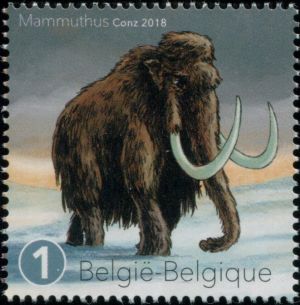 |
 |
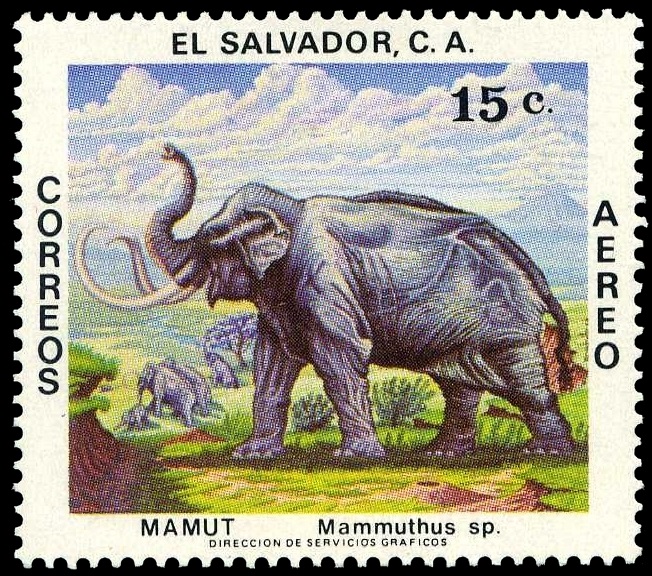 |
| Woolly Mammoths on stamps of Marshall Islands 2009 and Belgium 2018, MiNr.: 2520, Scott: 956c and MiNr.: 4853, Scott: respectively. |
Asian elephant (Elephas maximus) on stamp of Bangladesh 1977, MiNr.: 98, Scott: 134.
|
Columbian mammoth (Mammuthus columbi) on stamp of
El Salvador 1979, MiNr.: 1292, Scott: C458.
|
|
Description
 |
 |
| Mounted skeleton of the Siegsdorf specimen on imprinted stamp of personalized postal stationery and commemorative postmark issued for the "Fossils and Minerals 2015" trade show in Munich. |
 |
| Molar of primitive mammoth species Elephas/Mammuthus africanavus, with small number of ridges, on stamp of Tunisia 1982, MiNr.: 1034, Scott: 809F. |
 |
| Molar of woolly mammoth (Mammuthus primigenius), with a large number of ridges, discovered during construction in Berzdorf, on postmark of Germany 2005. |
One of the largest recorded woolly mammoths in Europe is the
Siegsdorf specimen from Germany,
with an estimated shoulder height of 3.49 metres and an estimated weight of approximately 8.2 tonnes.
In 2010, the discovery of a woolly mammoth trunk in Siberia revealed yet another adaptation: the skin of the trunk had a hood-like extension that may have functioned like a natural mitten, helping protect the sensitive tip from frostbite. Woolly mammoths likely shed their fur seasonally, with the densest layer being lost in the spring. A distinctive hump of fat on their backs acted as a reserve of energy and water, essential for survival in freezing conditions.
The woolly mammoth was herbivorous, feeding on the stems and leaves of steppe plants and shrubs. Fossil evidence suggests that woolly mammoths lived in family groups of 10 to 30 individuals, similar to modern elephants.
Mammoth tusks, which grew continuously throughout their lives, were typically curved and showed considerable variation in shape from one individual to another—some even developed unusually shaped tusks. These impressive structures likely played a role in foraging, particularly in helping the animals clear snow to reach the vegetation beneath during harsh winters.
Tusks also offer valuable insights into a mammoth’s age and life history. By examining a cross-section of a tusk, researchers can count growth rings much like those in trees. However, the earliest years of a mammoth’s life are often missing from the record, as the tips of the tusks—where those initial rings are located—tend to be worn away over time. In the remaining tusk, each major ring generally represents one year, with finer rings indicating weekly and even daily growth. Darker bands typically form during summer months, making it possible to determine not just the age of the animal, but even the season in which it died.
Mammoth species can be distinguished by the number of enamel ridges on their molars. Primitive species had fewer ridges, and this number gradually increased as new species evolved and replaced older ones. At the same time, the crowns of the teeth became longer, and the skulls became taller (from top to bottom) and shorter (from back to front) to accommodate these dental adaptations.
Woolly mammoths replaced their molars up to six times in their lifetime. Like modern elephants, they didn’t have a set of baby teeth followed by adult teeth as humans do. Instead, their large molars were replaced horizontally, from front to back, as the old ones wore down from grinding tough vegetation. The molar's location (front, middle, or back) gives clues about its stage in the eruption sequence.
Each new set of molars would slowly push the worn-out set forward and out of the jaw. Once the sixth and final set was worn down, the mammoth could no longer chew food effectively, which often led to starvation and death in old age.
The molars increased in both size and complexity with each replacement. Early molars (1st and 2nd) were smaller and had fewer enamel ridges (lamellae), typically up to six. Later molars (5th and 6th) were much larger, with up to 26 or more ridges, composed of tightly packed enamel plates ideal for grinding coarse grasses.
The degree of wear on a molar helps paleontologists determine whether the tooth was newly erupted or had been in use for many years.
Woolly Mammoth in human culture
The woolly mammoth (Mammuthus primigenius) was a prominent subject in Ice Age art, and its image is preserved in some of the world’s oldest known cave paintings. These artworks, created by Upper Paleolithic hunter-gatherers between 30,000 and 10,000 years ago, provide a unique glimpse into the relationship between prehistoric humans and the megafauna that shared their environment. Some of the most famous mammoth depictions can be found in caves in France and Spain, such as the Rouffignac Cave in Dordogne, France, also known as the "Cave of the Hundred Mammoths".Here, charcoal drawings and engravings on limestone walls portray mammoths in various poses, sometimes alone and sometimes alongside other Ice Age animals like bison, horses, and woolly rhinoceroses.
 |
 |
| The woolly mammoth (Mammuthus primigenius) and other Ice Age animals on the paintings from Rouffignac Cave in Dordogne on postmark (1975) and postage stamp (2006, MiNr.: 4079, Scott: 3197) of France. | |
The details in these images, including the curved tusks, domed heads, a humps, and shaggy outlines show a keen observation of these animals’ features. Due to the fact that the hump is not observed in fossils, the cave art really helps with reconstruction of the animal. These cave paintings are not only remarkable for their artistic value but also for their archaeological significance. They suggest that mammoths played an important role in the lives and beliefs of the people who created them, whether as a source of food, materials, or as part of spiritual or ritual practices. Today, these ancient artworks continue to fascinate scientists and the public alike, offering a window into Ice Age ecosystems and the creativity of early humans.
Mammoth ivory was one of the most prized materials used by Upper Paleolithic people for creating tools, ornaments, and art.
 |
| Paleolithic art figures from mammoth ivory on Souvenir-Sheet of Germany 2025, MiNr.: Bl. 94 (3907), Scott: . |
Some of the most famous examples of Ice Age mammoth ivory art come from sites in Germany, such as Vogelherd and Hohle Fels caves. These include small, finely carved figurines of animals: mammoths, bison, horses, cave lions, and even the Venus of Hohle Fels, one of the oldest known representations of the human form, dated to around 35,000 – 40,000 years ago.
Ivory was also used to create decorative beads, pendants, and spear points, often with intricate engravings. The choice of mammoth ivory may have held symbolic significance as well, given the animal’s importance for survival and its imposing presence in the Ice Age landscape. These artifacts not only demonstrate exceptional craftsmanship but also provide insight into the spiritual and cultural world of Ice Age peoples.
In 1985, archaeologists discovered a remarkable crescent-shaped boomerang in Oblazowa Cave, located in southern Poland. Carved from the tusk of a woolly mammoth (Mammuthus primigenius), the artifact measures 72 centimetres in length and has been radiocarbon dated to between 39,000 and 42,000 years ago - making it the oldest known boomerang in the world. This ancient tool features a curved shape and a flat-convex cross-section, strikingly similar to traditional non-returning boomerangs used by Aboriginal Australians for hunting and ceremonial purposes. Its discovery challenges long-standing assumptions that such sophisticated weapons originated solely with Aboriginal cultures, suggesting that complex projectile technology was developed independently in Ice Age Europe.
The boomerang’s decorative carvings and traces of red pigment, along with its discovery near symbolic and ornamental objects, suggest it may have served a ceremonial or symbolic purpose rather than being a purely functional hunting tool. Interestingly, the exact species responsible for crafting and using the boomerang remains uncertain. Oblazowa Cave was occupied during the Early Upper Paleolithic period, a time when both Neanderthals and Homo sapiens are known to have inhabited the region, between roughly 300,000 and 12,000 years ago.
Our ancestors hunted mammoths for their meat and bones, but there is no evidence that human hunting alone was responsible for the extinction of these animals. At the Mezyn Paleolithic Camp (today known as Mezin 22) in Ukraine, the remains of over 100 individual mammoths — along with the bones of wolves and deer — have been found.
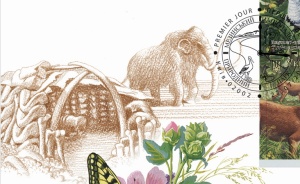 |
| A mammoth and dwelling of hunters for mammoths on cachet of the FDC with Mezyn National Nature Park stamps of Ukraine 2019. |
The Mezinian dwellings represent a significant evolution in prehistoric architecture. For the first time, structures had foundations formed by a ring of mammoth skulls. Surrounding the huts was a circle of pits of various sizes, depths, and contents. Some pits, containing large mammoth bones, may have served as storage for reserve building material. Others, filled with mixed bones and artifacts, were likely used as refuse pits. Hearths were sometimes placed above pits filled with debris.
In addition to the structural remains, numerous artistic and functional objects were unearthed at the site: decorated figurines carved from mammoth ivory, meander-pattern bracelets, and a painted set of musical instruments made from animal bones.
In 1965, the "Mezyn Archaeological and Research Museum" was established at the site to preserve and showcase these important discoveries.
 |
 |
 |
| Human ancestors (Cro-Magnons, Neandertal) hunting woolly mammoth (Mammuthus primigenius) on stamps of Ukraine 2017, MiNr.: 1597, Scott: ; France 2008, MiNr.: 4178, Scott: 3433; Cuba 2008, MiNr.: 5112, Scott: 4905. | ||
Early Discoveries and Myths
In the early 17th century Europe, the term “mammoth” derived from the Russian word "mamont" (sometimes also transliterated as "maimont" or "maimonto") first appeared in reference to the large fossilized tusks being unearthed in Siberia. The Russian word "mamont" likely originates from a word in the Mansi language, spoken by Indigenous peoples of northern Siberia, meaning “earth horn”. |
| Skeleton of woolly mammoth on postcard issued by Paleontological Museum in Moscow, Russia in 1995. |
In 1618, Richard James, an English scholar and traveler, documented the word "maimanto" in a Russian–English glossary he compiled during a diplomatic journey to Russia. This glossary contains the earliest known use of the term in European literature, where he recorded "maimanto" as a local explanation for the mysterious giant fossil tusks found in Siberian permafrost.
Richard James (1592–1638) was a scholar, poet, traveler, and linguist, best known for this early 17th century expedition to Russia and for compiling what is now considered the first recorded European reference to the mammoth, under the name "maimanto". He later became the first librarian of the Cottonian Library, a foundational collection that would eventually form part of the British Library.
In the 17th century, mammoth ivory was so abundant that it was exported in quantity to both China and Europe. The word "maimanto" (later transformed to mammoth) gradually entered wider usage in Europe, especially as fossilized remains of large proboscideans (elephant-like animals) were increasingly discovered—not only in Russia but also in parts of Germany, France and England.Today, the woolly mammoth is formally classified as Mammuthus primigenius. The genus name Mammuthus is directly inspired by the old Russian "mamont", preserving the legacy of the people who first uncovered their remains.

Transport of Mammoth tusks from Yakutsk, Siberia on postcard of Russia 1910s. |
Siberian mammoth ivory is reported to have been exported to Russia and Europe as early as the 10th century. When Russia conquered Siberia in the 16th and 17th centuries, the ivory trade expanded significantly, and mammoth ivory became a widely exported commodity, with large quantities excavated and traded. The first shipment of Siberian ivory to reach Western Europe arrived in London in 1611.
In his 1692 travelogue "Noord en Oost Tartarye", the Dutch mayor and scholar Nicolaes Witsen (1641-1717) provided the first known first-hand European account of a frozen mammoth. During his journey through Siberia, he described encountering enormous tusks and carcass fragments that were “dark brown in color and emitted a foul stench,” noting how deeply they were embedded in the ice and permafrost. Witsen’s observations—emphasizing both their remarkable preservation and pungent odor—offered early proof that these remains were neither mere mineral curiosities nor relics of giants, but the bodies of ancient pachyderms preserved by the Siberian cold.
According to some indigenous Siberian peoples, the mammoth was believed to be a creature that lived underground, burrowing tunnels as it moved. They thought it would die if it accidentally surfaced and was exposed to daylight or fresh air. In their view, mammoth tusks were considered horns. At the same time in Europe, discovered mammoth bones were often mistakenly identified as the remains of Biblical giants.
 |
| St. Stephen’s Cathedral in Vienna on stamp of Austria 1977, MiNr.: 1544,1545, Scott: 1055, 1056. |
 |
| Woolly Mammoths on stamp of Switzerland 2024, MiNr.: 2970, Scott: 1989. |
 |
| Chapel Bridge in Lucerne on stamp of Switzerland 2018, MiNr.: 2542, Scott: 1682. |
Workers uncovered a massive bone, later identified as the femur of a woolly mammoth, but at the time, its true origin was unknown. In keeping with medieval beliefs, the bone was thought to be the relic of a Biblical giant, perhaps linked to the legends of the Flood or mythic figures such as Gog and Magog. The bone was prominently displayed on the cathedral’s north gate, which came to be known as the Giant’s Gate (Riesentor).
In medieval Europe, it was common practice to display the bones of Biblical giants in churches, cathedrals, and town halls. Many churches across Europe exhibited large bones, now known to belong to woolly mammoths, woolly rhinoceroses, or other Ice Age megafauna.
For centuries, the bone remained a curiosity, reinforcing local myths about ancient giants who once roamed the land. It was not until 1613 that the bone’s true identity was recognized.Mammoth or elephant femur (hind leg bone) could easily be mistaken for those of a human giant, as it has a very similar shape, but much bigger, especially by someone without advanced anatomical knowledge.
The French medical student Jean Riolan the Younger correctly identified it as belonging to an extinct elephant, what we now know to be a woolly mammoth (Mammuthus primigenius).Today, this historic bone is preserved in the Geological Collection of the University of Vienna, where it serves as a reminder of how science gradually replaced myth in our understanding of Earth’s ancient past.
Another example are mammoth bones discovered in Switzerland in 1577 near the monastery of Reiden, later known in the literature as the "Giant of Reiden", the "Giant of Lucerne", or the "Swiss Giant". In "Geschichte der Mammutfunde", Professor Arnold Lang (1855–1914), a Swiss naturalist and comparative anatomist, described the story of this discovery:
In 1577, huge bones were found in Heiden in the canton of Lucerne under an oak tree that had been uprooted by a storm.
They were brought to Lucerne.
When the famous doctor Felix Plater was called to Lucerne in 1584 to care for the sick military colonel Ludwig Pfyffer,
the councilors showed him these bones - as Plater himself tells us in his Observationes medicete.
He examined them and could not believe that they were anything other than the bones of a giant.
The council decided to send him some of the larger pieces to Basel, where Plater compared them with the human skeleton pieces
in his possession and was confirmed in his belief that they were the bones of a human giant, with height of 5.5 meters.
Plater then had the Basel master painter Hans Bock make a drawing of the bones that had been reconstructed and supplemented
to form a gigantic human skeleton and sent the drawing back to Lucerne along with the bones.
In 1799, the renowned naturalist Johann Friedrich Blumenbach (1752–1840) from Goettingen (now part of Germany) correctly identified these fossils as the bones of a mammoth. He took two of the bones with him for further study. Today, casts of these bones can be seen at the Natural History Museum in Lucerne. The earlier misidentification by Plater was due to the similarities between the foot bones of large mammals such as the elephant, which was unknown in 16th century Switzerland and those of humans. The absence of a skull or tusks at the discovery site further contributed to the confusion.
Scientific Study and Major Discoveries
The earliest paleontological research on woolly mammoths
The earliest paleontological research on mammoth bones and tusks was carried out by the Russian statesman and historian Vasily Nikitich Tatishchev (1686–1750).
 V. N. Tatishchev, USSR 1991, MiNr. 6253, Scott. 6052
V. N. Tatishchev, USSR 1991, MiNr. 6253, Scott. 6052
|
The Ural Mountains or simply the Urals are a mountain range that runs approximately from north to south through western Russia, from the coast of the Arctic Ocean to the river Ural and north-western Kazakhstan. The mountain range forms part of the conventional boundary between the continents of Europe and Asia.
Upon his arrival in the Urals, Tatishchev began collecting folklore about a mysterious animal - the mammoth. He dedicated considerable effort to gathering remains of this animal “to see and investigate it”. Tatishchev obtained tusks from the towns of Yakutsk and Berezov, as well as a piece of mummified carcass from Tyumen. He also had the opportunity to examine part of a mammoth skull from the collection of the governor of Tobolsk.Upon Tatishchev's reports, in 1722 Tsar Peter the Great issued a decree directing the governor of Siberia to locate a complete mammoth carcass and dispatch it to St. Petersburg for display in the imperial Cabinet of Curiosities (the Kunstkamera - Russia’s first state museum and the seed of the Russian Academy of Sciences). However, despite numerous expeditions, the Tsar’s wish for an intact mammoth carcass went unfulfilled for nearly a century.
In 1724, Tatishchev traveled to Sweden to study mining sciences. While in Stockholm, he was introduced to Swedish scientists who were studying the peoples and animals of northern Europe. In the following year, Tatishchev published an article about his investigations of mammoth remains: "Mamontova Kost' hoc est Ossa Subterranea, Fossilia, Ingentia, Ignoti Animalis, E Siberia Adferri Coepta, Duabus Perillustrium Atque Generosissimorum Virorum Literis, Brevique Commentario Dilucidata", intended to satisfy the curiosity of Swedish scholars regarding the mammoth.
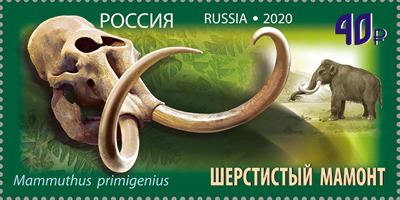
|
| Reconstruction and skull of Woolly mammoth (Mammuthus primigenius) on stamp of Russia 2020, MiNr.: 2873I; Scott: 8169c. |

|
| Skull of Mammuthus primigenius on stamp of Jersey 2025, MiNr.: ; Scott: . |
 |
| Skeleton of woolly mammoth (Mammuthus primigenius) on personalized self-adhesive stamp "75 years of the discovery of a mammoth in Nevlje by Kamnik" of Slovenia 2013, issued by Philatelic Club of Kamnik. |

|
| The drawing of merchant Roman Boltunov from Yakutsk - the first mammoth reconstruction |
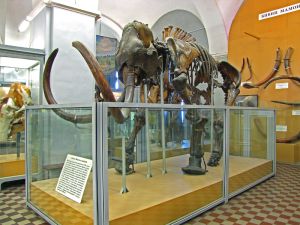 |
| Adams' Mammoth on exhibit at the Zoological Museum of the Academy of Sciences in St. Petersburg |
 |
| The Kunstkamera or Zoological Museum of the Russian Academy of Sciences on stamp of USSR 1949, MiNr.: 1313, Scott: 1322. |
Tatishchev believed that the mammoth was not an elephant, but a distinct animal whose “horns” were extracted and traded under the name “mammoth bone”.
One of the first scientists in Western Europe to propose that mammoth remains belonged to an extinct species of elephant was the British physician and naturalist Hans Sloane (1660–1753). An Irish-born collector, Sloane's extensive holdings later formed the foundation of the British Museum, the British Library, and the Natural History Museum in London.
When Sir Isaac Newton died in March 1727, Hans Sloane succeeded him as President of the Royal Society, formally known as the Royal Society of London for Improving Natural Knowledge.
In 1728, drawing on travelers’ accounts and a limited number of bones discovered in Siberia and Britain, Sloane publishedAn Account of Elephant’s Teeth and Bones Found Under Ground. In this work, he examined whether these remains were truly those of elephants, though he ultimately reached no firm conclusion.
The earliest recorded discovery of mammoth bones in Britain occurred in 1690, during trench excavation for construction in the Gray’s Inn Lane area of central London, just north of Holborn. Workers uncovered a large fossilized tooth along with parts of a tusk—remains unlike anything commonly recognized at the time. The discovery drew the attention of John Conyers, an apothecary and one of the earliest English antiquarians. Conyers examined the tooth and correctly proposed that it belonged to an elephant. This find holds particular historical significance, as it was among the first in Britain to be interpreted through a naturalistic lens rather than a mythical or biblical one. It represents an early step in the development of paleontology and the understanding of deep geological time. John Conyers’ interpretation, that the fossil was from an elephant, would be confirmed in later centuries as scientific understanding grew. It is now known that the remains belonged to a woolly mammoth (Mammuthus primigenius), a species that roamed Ice Age Britain during the Pleistocene Epoch (roughly 400,000 to 10,000 years ago).
Sloane offered a biblical explanation for the presence of elephant remains in Arctic regions, suggesting they had been buried during the Great Flood, and that Siberia had once been a tropical region before undergoing a drastic climate change. Some of his contemporaries interpreted his views differently, arguing that the flood had transported elephants from tropical regions to the Arctic.Tatishchev rejected the then-popular theory that the “ivory” bones found in Siberia had been carried there by the waters of Noah’s Flood from India, instead he insisted that the mammoth remains were found in places where the animals had once lived. Tatishchev even proposed that Siberia had, in the distant past, been situated closer to the Equator and had a much warmer climate.
In his later writings, Tatishchev acknowledged that mammoth bones closely resembled those of Indian elephants, yet he continued to reject the idea that they had been transported from India by the waters of the Biblical Flood.
He actively encouraged local residents to search for complete mammoth skeletons. Unfortunately, it was not until about half a century after his death that a complete mammoth skeleton was finally discovered.
The first woolly mammoth Skeleton
The first almost intact mammoth skeleton, including some remains of soft tissue, was discovered by an Evenki (one of the indigenous peoples of the Russian North) hunter, Ossip Shumachov in 1799 at the delta of the Lena River on the Bykovsky Peninsula. However, Shumachov had to wait another four years for the bluff to erode enough to allow the tusks to be removed.These well-preserved tusks, each about 2.7 meters long, were eventually sold to a Yakutsk merchant, Roman Boltunov, for a sum equivalent to around $2,000 today.
Boltunov, aware of the keen interest in mammoth remains among scientists in Russia and abroad, persuaded the hunter to guide him to the carcass. The carcass looked like the remains of an enormous animal, the largest Boltunov ever seen, covered with long, rust-coloured fur, with very thick legs. Boltunov took measurements at the site and marked the location of the carcass. After returning home, he made a drawing of the animal based on his notes and his imagination, referencing animals familiar to him. The only large animal he knew with thick legs and tusks projecting from its head was a boar.
In his drawing, the tusks appeared oddly positioned - one seemed to point upward, the other downward, though they were correctly placed in the upper jaw. For some reason, Boltunov did not consult the hunter about the tusks' original orientation before they were removed. At the time, most scientists incorrectly believed that mammoth tusks pointed outward.
In 1806, zoologist and botanist Mikhail Ivanovich Adams (1780–1832), who was in Yakutsk at the time, learned of the mammoth discovery. Although Adams dismissed Boltunov’s drawing as “very incorrect,” he forwarded it to the Academy of Sciences in St. Petersburg (then the capital of Russia) along with a letter outlining his intention to set aside his plant-collecting work and urgently travel to the site to secure the skeleton.
By the time Adams arrived at the location - after many months spent organizing the expedition and obtaining the necessary permissions - most of the flesh and internal organs had been devoured by polar bears, foxes, and even the dogs of local hunters. The trunk, tail, and one of the forelegs, including its shoulder blade, were also missing. However, most of the skeleton remained intact, with many bones still connected by ligaments and skin. Even with one leg missing, this was by far the most complete mammoth skeleton ever recovered at that time.
In 1808, Wilhelm Gottlieb Tilesius (1769–1857), a zoologist and artist, mounted the skeleton at the Kunstkamera (later part of the Zoological Museum of the Russian Academy of Sciences) in St. Petersburg, where it was exhibited to the public for the first time. Some missing bones were replaced with wooden casts, and the tusks were incorrectly mounted, pointing outward rather than curving inward as they would have in life, because Tilesius placed each tusk in the opposite socket.
Samples of skin and hair from the carcass were sent to various museums in Europe and America. This remarkable discovery provided definitive evidence that the mammoth was not simply an Indian elephant; its thick woolly coat and distinct anatomical features made it clear that it was a unique species adapted to cold climates.
Reconstructing the skeleton dispelled any lingering doubts that the mammoth belonged to the elephant family and confirmed it as a distinct species, separate from both African and Asian elephants. Even today, the skeleton remains an important fossil for comparison in new discoveries.
Berezovsky Mammoth
Another famous Russian mammoth is the Berezovsky Mammoth, which was also chosen as the logo of the Zoological Museum of the Zoological Institute of the Russian Academy of Sciences in St. Petersburg.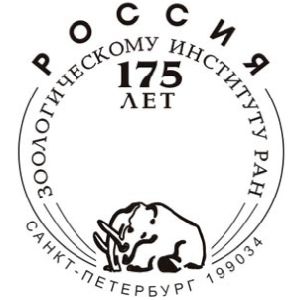 |
 |
| Berezovsky Mammoth on commemorative postmark of Russia 2015. Once introduced in 2007 for 175th anniversary of Zoological Institute of Russian Science Academy in St. Petersburg, this postmark was in use, probably even in use to date, and exist in several colour variations: red, blue, black. |
The Berezovsky Mammoth on postmark of Finland 1985.
The postmark was issued for "ESPOO-ESBO All about Mammoths" exhibit, which took place in
Espoo city in July 1985.
|
 |
|
| Zoological Museum of the Zoological Institute of the Russian Academy of Sciences in St. Petersburg on the cachet of Russian postal stationery 2007. | |
It was named after the Berezovka River, on whose banks it was discovered in 1900, frozen in a cliff. The mammoth was identified as a bull, aged between 35 and 40 years, and dated to about 40,000 years old through radiocarbon analysis.
Its unusual posture and numerous broken bones suggest that it fell into a crevasse. Because plant remains in its mouth contained seeds, the accident likely occurred at the end of summer or early autumn - a time when the surface soil was still loose from the summer thaw, but falling temperatures allowed the rapid freezing of the buried mammoth.
The stuffed replica, covered with the original skin and hair is on display in the Zoological Museum in St. Petersburg. Since the Soviet era, this reconstruction has been displayed internationally as part of Russian mammoth exhibitions.
Today, the skeleton of Adams Mammoth, with its tusks mounted correctly in 1899, and the cast of the Berezovsky Mammoth are on display at the Zoological Museum of the Zoological Institute of the Russian Academy of Sciences in St. Petersburg. The museum was established in 1832, following the separation of the zoological collection from the Kunstkamera.
The Adams mammoth skeleton represented the culmination of generations of intellectual evolution, marking the shift from dismissing giants and mythological creatures to accepting the challenging concepts of extinction and Earth’s immense age.
The first skeleton mounted outside of Russia
The first woolly mammoth (Mammuthus primigenius) skeleton mounted in Western Europe is the Lier Mammoth, discovered on 28 February 1860 by François-Joseph Scohy in Lier, in the province of Antwerp, Belgium, while digging the diversion canal of the Nete river. First exhibited to the public in 1869, it was only the second mounted mammoth skeleton in the world, and the first mammoth skeleton discovered outside the permafrost regions of Siberia.Based on the length of the right tusk that was recovered (the left tusk is a reconstruction), the skeleton is believed to have belonged to a male mammoth that died at an age of 30–35 years. Because the skeleton was incomplete, some bones were recreated in wood. Originally, all recreated bones were white, as can be seen in the video below, but today they are painted to match the colour of the original bones and are not easily distinguishable.
Today, the Lier Mammoth skeleton is preserved at the Royal Belgian Institute of Natural Sciences in Brussels, while a 3D-printed replica is on display at the Lier City Museum.
Woolly Mammoth Identification
In 1799, the same year the Adam's mammoth skeleton was discovered in Siberia, the German naturalist Johann Friedrich Blumenbach (1752-1840) gave the woolly mammoth its scientific name, Elephas primigenius, placing it in the same genus as the Asian elephant. |
 |
| Johann Friedrich Blumenbach (1752-1840). | Wilhelm Ernst Tentzel (1659 -1707). |
| Images credit: Wikimedia. | |
In this book, Blumenbach referred to elephant bones that had been unearthed in late 1695 from
a sand pit near the settlement of Burgtonna, close to the town of Gotha in
Germany.
These fossils sparked controversy at the time of their discovery, as their origin was hotly debated
marking the first scientific debate about the nature of mammoth bones.
The scientific community in Gotha (Collegium Medicum) regarded the bones as being of mineral
origin, reflecting the common belief of that era that fossils were mineral formations rather than
remains of once-living creatures.
However, the German historian Wilhelm Ernst Tenzel argued otherwise.
In his 1696 Latin work "Epistola de sceleto elephantino", he claimed that these bones
belonged to an elephant that had likely perished during the Biblical Flood.
 |
| Wilhelm Leibniz on stamp of Germany 1980, MiNr.: 1050; Scott: 1329. |
One of the notable figures with whom Tenzel corresponded was
Gottfried Wilhelm Leibniz (1646–1716), the renowned German polymath,
who made major contributions to mathematics, co-developing calculus independently of Isaac Newton,
and to fields such as philosophy, physics, and linguistics,
who also took a keen interest in natural history.
In his correspondence with Tenzel, Leibniz discussed the true nature of the fossil.
Initially, Leibniz agreed with Tenzel that these remains were from once-living animals,
but hypothesized that they might have belonged to marine creatures.
However, after further reflection and comparison, Leibniz concluded that the bones likely belonged
to elephants.
To explain the presence of elephant remains in Central Europe, he proposed two possible scenarios:
that these bones belonged to a species of elephant adapted to cold climates,
or
that Central Europe once had a warmer climate in the distant past, suitable for elephants to live there
naturally.
Leibniz’s reasoning reflected a significant shift in thinking during the late 17th
and early 18th centuries, away from mythological explanations and toward scientific
interpretations grounded in comparative anatomy and environmental change.
Further discoveries in 1699, including a skull, teeth, and tusks at a nearby site
were cited by Tenzel as evidence supporting his theory.
Blumenbach’s original specimens were believed lost or destroyed during the Second World War,
but they were rediscovered at Goettingen University in 2008.
 |
| Baron Georges Leopold Cuvier on personalized stamp, postmark and the cachet of the souvenir cover. The cachet show Tilesius's drawing of the Adams mammoth skeleton. |
Cuvier compared these remains with the skeletons of Indian and African elephants and concluded that mammoths were not the ancestors of modern elephants. Instead, he recognized them as belonging to a distinct, extinct group of Proboscideans.
In 1828 Joshua Brooks used the modern scientific name Mammuthus primigenius for the woolly mammoth in his catalogue "A catalogue of the anatomical and zoological museum of Joshua Brooks".
The First Evidence of Humans and Mammoths Coexisting
During the 19th century, many scientists firmly rejected the idea that humans had coexisted with prehistoric animals like the woolly mammoth. According to prevailing beliefs at the time, shaped by religious doctrine and early interpretations of Earth’s history, such animals were thought to have been created and gone extinct long before the first humans appeared, possibly even before humanity was believed to have descended from Paradise.
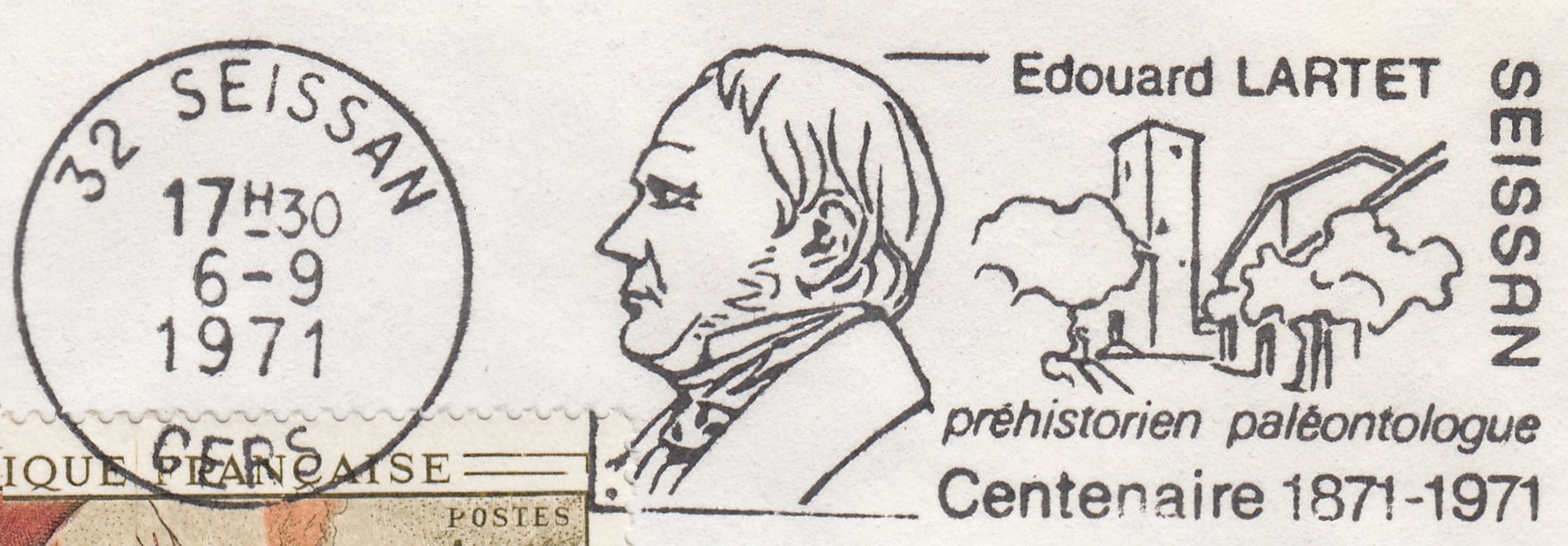 |
| Edouard Lartet on postmark of France 1971 |
 |
| Neanderthal man from La-Chapelle-aux-Saints at the entrance of the prehistoric museum of Les Eyzies de Tayac on meter franking of France 2006 |
That perception began to shift in 1864, when French paleontologist Edouard Lartet (1801–1871) made a ground-breaking discovery in the Abri de la Madeleine, a prehistoric cave site in the Dordogne region of France. There, he uncovered a piece of mammoth ivory engraved with the image of a woolly mammoth, complete with a distinctive humped back and curved tusks.
This engraved ivory, now famously known as the "Mammoth from La Madeleine", was the first widely accepted artistic representation of a now-extinct prehistoric animal created by early humans. It provided compelling evidence that humans not only lived alongside mammoths during the Ice Age, but also observed and depicted them in their art, likely as part of their cultural or spiritual life.
The find was a turning point in both paleontology and archaeology, helping to usher in a new era of understanding about the deep antiquity of human existence and our interactions with the megafauna of the Pleistocene Epoch.
Major Discoveries in Europe outside of Siberia
Since at least 1874, numerous fossils (separate bones) of the woolly mammoth have been discovered in the bed of the North Sea between Great Britain and the Netherlands. One notable example is a mammoth skull from the collection of the Natural History Museum Rotterdam, which was recovered by a sand dredger in the floodplains of the Meuse River near Gewande, North Brabant. It appears that the area between the Great Britain and the Netherlands, in the Pleistocene Epoch, was not the North Sea we know today. Instead, it formed part of a vast, mostly treeless dry steppe, a megafaunal landscape where rivers such as the Thames, Rhine, Meuse, and Schelde meandered across plains and joined into river deltas before flowing into the Atlantic Ocean far to the north. This extensive steppe stretched across much of the Northern Hemisphere, providing a habitat for mammoths, woolly rhinos, giant deer, steppe bison, aurochs, and large predators such as saber-tooth cats and cave bears.
 |
 |
| Mammoth's molar and reconstructions of mother with calf on personalized stamps of the Netherlands 2023. | |
Another remarkable location where mammoth bones have been discovered is the island of Jersey.
 |
| Woolly mammoth (Mammuthus primigenius) and its molar on stamp of Jersey 2010, MiNr.: 1523 ; Scott: 1478. |
Mammoth bones have been unearthed at several sites on Jersey, most notably in La Cotte de St. Brelade, a dramatic cave and fissure site on the island’s south coast. Archaeological excavations at La Cotte have revealed that Neanderthals once used this location as a hunting and butchering site. Layers of sediment, dating back more than 200,000 years, contain large numbers of mammoth bones, along with the remains of woolly rhinoceroses and other Ice Age animals.
One of the most fascinating aspects of the La Cotte site is the evidence that early humans may have deliberately driven mammoths and other large prey over the cliffs to their deaths - a rare example of sophisticated group hunting behaviour in Europe during the Middle Pleistocene.
Today, the mammoth bones from Jersey provide valuable insight into the environment of the time, the survival strategies of Neanderthals, and the rich megafauna that once roamed the now-submerged landscapes connecting Britain and mainland Europe.
 Neanderthal hunt woolly mammoths on "Europa 1994 - Discoveries and Inventions" stamps of Jersey,
MiNr.: 650-651; Scott: 667a.
Neanderthal hunt woolly mammoths on "Europa 1994 - Discoveries and Inventions" stamps of Jersey,
MiNr.: 650-651; Scott: 667a.
Fossils of woolly mammoths have been found at numerous locations across Britain, including in river valleys, gravel pits, and along the coast. Notable discoveries include teeth, tusks, and bones unearthed at sites such as Ilford in Essex, Shropshire, Norfolk, and Kent. These remains date primarily to the last glacial period, between about 100,000 and 12,000 years ago, when Britain was periodically connected to continental Europe by land bridges.
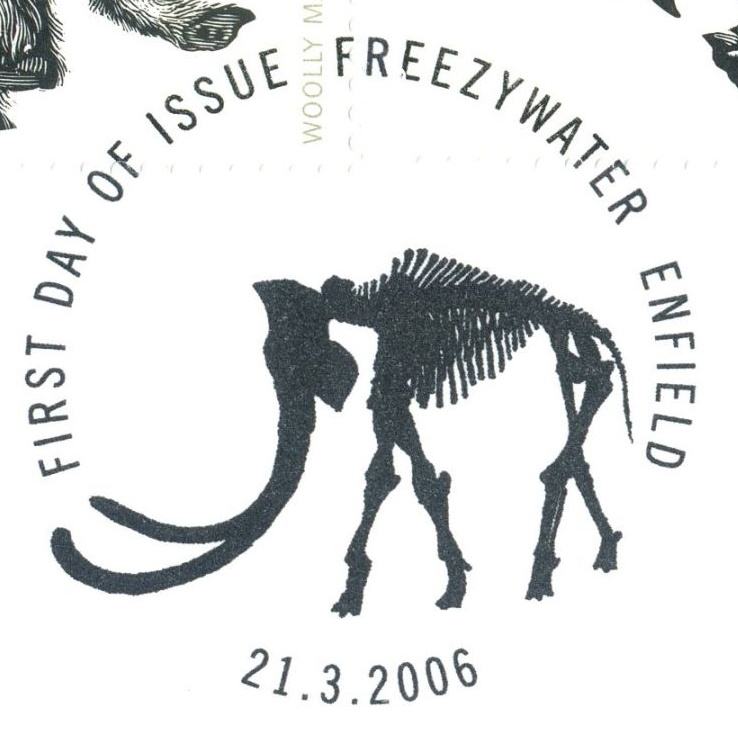 |
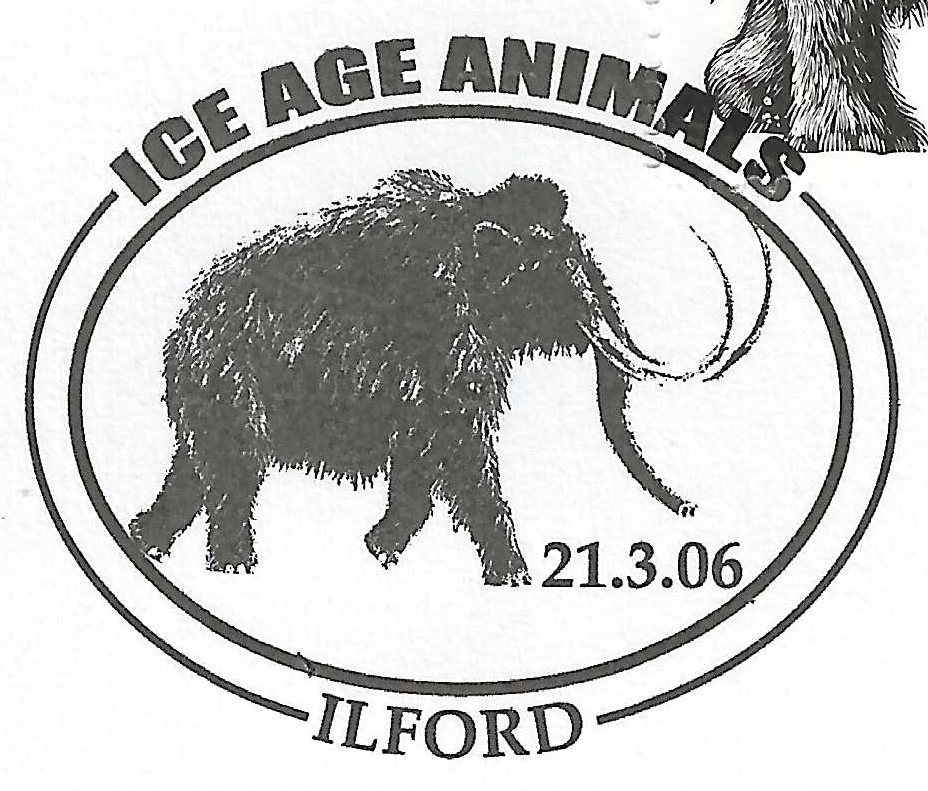 |
| Woolly mammoth (Mammuthus primigenius) on postmark of Great Britain 2006. | |
Excavations revealed a rich assemblage of bones from at least six mammoths, along with remains of woolly rhinoceroses, giant deer, and wild horses. The bones were found in ancient river gravels and floodplain deposits, dated to around 200,000 years ago—a time when the Thames Valley supported a cold-steppe ecosystem, similar to the mammoth steppe of Siberia.
The site provided valuable information about the environment of Ice Age Britain and the animals that lived alongside the mammoth. The discovery of articulated bones and associated species also shed light on the composition of Pleistocene faunal communities in southern England. Today, fossils from Stanton Harcourt are housed in institutions such as the Oxford University Museum of Natural History.
Discoveries of Woolly Mammoth in Asia
 |
| Woolly mammoth, woolly rhino and "Peking Man" on stamp of China 1991, MiNr.: 2380, Scott: 2346 (this stamp exist in two perforation variants). |
 |
| Woolly mammoth (Mammuthus primigenius) on stamp of Mongolia 2023 MiNr.: 4299, Scott: 3057b. |
Woolly mammoth remains in Asia are often limited to scattered bones, tusks, or molars, but the 1979 discovery of the so-called "Weifang Elephant" in Shandong stands out as a remarkable exception. During drought-relief well-digging in Wujia Village, local villagers unearthed a trove of fossils about 3 meters deep. What emerged was an unusually complete skeleton, including a nearly intact skull, both tusks (each approximately 3.05 meters long), the jaw, vertebrae, ribs, shoulder, and thigh bones.
The mammoth is believed to have been a young adult, around 18–20 years old, standing over 4 meters tall at the shoulder, with an estimated body length of 8.5 meters and a weight between 6 and 10 tons. Based on sediment analysis, it lived during a glacial period between 100,000 and 200,000 years ago, when the region experienced a much colder and drier climate than it does today.
This important discovery provides strong evidence that woolly mammoths once roamed far into what is now temperate and subtropical China, adapting to shifting environmental conditions during the Pleistocene Epoch.
The "Weifang Elephant", though originally described as a separate species (Mammuthus weifangensis), is now best understood as a large regional variant of the woolly mammoth (Mammuthus primigenius). It represents the largest mounted skeleton of a woolly mammoth to date — a towering reconstructed model measuring 4.8 meters in height, 8.5 meters in length, with tusks extending 3.7 meters - on display at the Weifang Museum.
Mongolia may not be the first place that comes to mind when thinking of woolly mammoth (Mammuthus primigenius) fossils, yet it holds some remarkable discoveries. In 1998, a joint expedition by the National University of Mongolia and the Khovd branch of the university unearthed the remains of a woolly mammoth in the Teserkhii area of Buultin Bulag, located in Durgun village. The team recovered around 70% of the skeleton, making it one of the most significant mammoth finds in the country. Before this discovery, scientists had little concrete evidence—aside from cave paintings—that mammoths once roamed the Mongolian steppes. Today, these important fossils are housed in the National Museum of Natural History in Ulaanbaatar, where they continue to contribute to our understanding of Mongolia’s Ice Age past.
One of the most well-known depictions of woolly mammoths in Mongolian cave art comes from Khoit Tsenkher Cave (also known as Gurban Tsenkher), located in Khovd Province, approximately 25 km west of Mankhan at an elevation of around 1,571 meters. Discovered by geologist O. Namnandorj in the 1950s, the cave features Paleolithic artwork estimated to be 30,000 to 40,000 years old. These ancient images were first engraved into the rock and later painted using red and brown ochre. Among the animals depicted are woolly mammoths, as well as lions, camels, oxen, ibex, and antelope—offering a vivid glimpse into the Ice Age fauna that once inhabited the region.
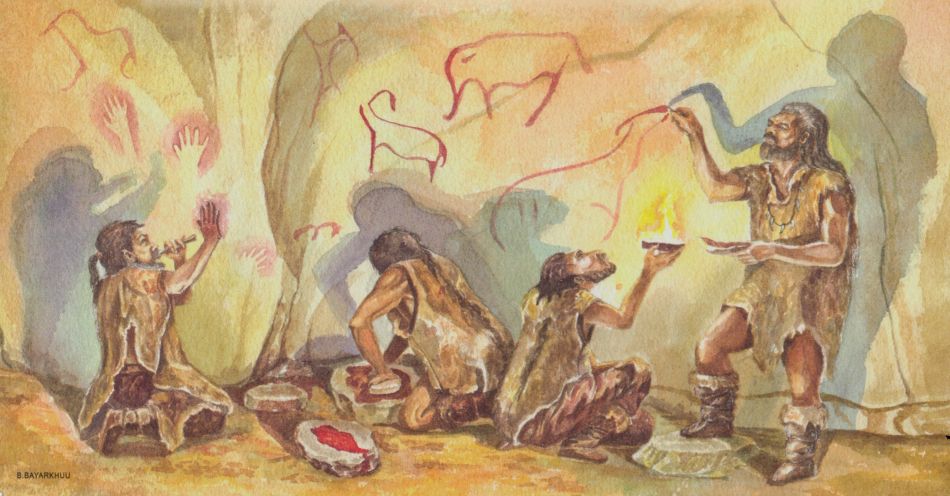
Prehistoric painters on margin of the Mini-Sheet of Mongolia 2023
Discoveries of Woolly Mammoth in North America
Even though most well-preserved skeletons and carcasses of woolly mammoths have been discovered in Siberia, some important finds have also been made in North America.The frozen ground of Alaska (USA) and the Yukon (Canada) has revealed some of the most important woolly mammoth finds in North America. These regions, once part of the great Bering Land Bridge that connected Asia and North America during the Ice Age, preserve a treasure trove of mammoth fossils — from massive tusks to rare frozen remains.
 |
| Woolly Mammoth on stamp and cachet FDC of USA 1996 MiNr.: 2736, Scott: 3078. |
In 1948, gold miners near Fairbanks, Alaska uncovered the partial frozen remains of a woolly mammoth (Mammuthus primigenius). The specimen nicknamed "Effie", after the nearby village of Ester, represents one of the most complete mammoth finds in North America.
Effie’s remains include parts of the head, foreleg, skin, and even patches of reddish-brown hair — rare for mammoth fossils discovered outside of Siberian permafrost. The specimen was estimated to be about 21,000 years old, dating to the Late Pleistocene, when mammoths roamed the cold grasslands of Beringia.
Beringia refers to the vast land and sea region surrounding the present-day Bering Strait that, during Pleistocene glacial periods, formed a continuous land bridge between north-eastern Asia and north-western North America.
Effie is notable not only for its preservation but also for providing valuable insight into mammoth anatomy, hair structure, and the Ice Age environment of Alaska. Today, the remains are part of the collection at the American Museum of Natural History in New York City, where they continue to contribute to scientific research and public education.Among the most important woolly mammoth discoveries in the United States are the "Schaefer" and "Hebior" mammoths, both unearthed in the state of Wisconsin. These two specimens have provided compelling evidence that Paleo-Indians, the earliest known inhabitants of North America, hunted or scavenged mammoths for meat.
Excavations revealed cut marks on the bones, as well as signs of systematic disarticulation, strongly indicating that the animals had been butchered using stone tools. In the case of the "Hebior" mammoth, over 85% of the skeleton was recovered, making it one of the most complete mammoth specimens ever found in North America.
The "Schaefer" mammoth, similarly, showed clear traces of human activity, with remains dated to approximately 14,000 years ago, pushing back the timeline of human presence in the region. These finds are among the earliest solid proofs of human-mammoth interaction in the Americas and support the idea that mammoths were not only observed by prehistoric humans but also served as a vital food source.
The Klondike goldfields near Dawson City (Yukon, Canada) are world-famous not just for gold, but for their rich Ice Age fossil beds.
 |
| Woolly Mammoth on stamp of Canada 1994, MiNr.: 1449, Scott: 1532. |
The mammoth trackways discovered in 1999 at St. Mary’s Reservoir (when it was drained) in western Canada offer paleontologists valuable insight into mammoth behaviour. The tracks left by a mix of juveniles, subadults, and adults confirm that woolly mammoths were social animals that lived and moved in herds.
In 2022, a mummified ice age specimen of a woolly mammoth was discovered in the Un Klondike area of Yukon in northern Canada, on a site belonging to the Trʼondek Hwechʼin First Nation. The mammoth baby, thought to be female, was named "Nun Cho Ga", meaning "Big Baby Animal" in the Hen language.
The mammoth remains from Alaska and Yukon help scientists piece together the story of the Beringian steppe-tundra, the mammoth’s Ice Age home. Studies of these fossils shed light on mammoth diets, physical adaptations, migration patterns, and their eventual extinction. Today, mammoth tusks and bones are still found in these regions, offering new clues about life during the last Ice Age.
International Research on Siberian Discoveries
More than 20 mammoth remains, including frozen carcasses and skeletons with soft tissue and skin still attached, have been discovered in Siberia to date. It is likely that many more carcasses remain partially or fully frozen in the permafrost. Even today, accessing the remote corners of Siberia is challenging, and recovering a body from the frozen ground and transporting it to a laboratory for study remains a complex and demanding task. However, with the increasing development and infrastructure expansion in Siberia during the 20th and 21st centuries, the region has become more accessible, leading to a significant rise in the number of discoveries. |
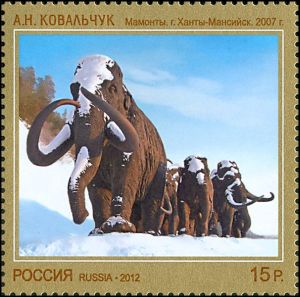 |
|
The Mammoth monument in front of the Permafrost Research Institute on cachet
of Soviet pre-stamped cover.
|
Mammoth sculpture from the "Ice Age Animals" park in Khanty-Mansiysk on stamp of Russia 2012, MiNr.: 1847, Scott: 7384. |
Many “Mammoth Discovery” expeditions were organized by Soviet scientists. The Permafrost Institute, founded in 1960 in Yakutsk, is part of the Siberian Branch of the Russian Academy of Sciences and is dedicated to both basic and applied research in two broad areas:
- the evolution of permafrost in relation to natural and human-made factors
- the thermal and mechanical interactions between engineering structures and permafrost
In 2007, the Ice Age Animals life-size sculpture park was opened in another Siberian city — Khanty-Mansiysk. The statue of a group of mammoths on a marsh was depicted on a Russian stamp from the "Modern Art of Russia" set issued in 2012.
Cerpolex Mammuthus'99 Project
Following the collapse of the Soviet Union, Russian scientists continued their expeditions into the vast wilderness of Siberia in search of mammoth fossils. These scientific endeavours were often conducted in collaboration with institutions from the United States, Europe, and Japan. Faced with limited funding, some of these expeditions turned to an unexpected source of support: philately.One notable example of modern mammoth exploration was an expedition organized by the French travel company Cerpolex (Cercle Polaires Expeditions — “Polar Circle Expeditions”).
 |
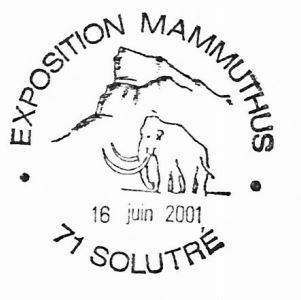 |
| Woolly Mammoth on postmarks of France 1999 and 2001. |
His involvement with mammoth research began in 1997 after an encounter with the Jarkov family, members of the indigenous Dolgan community — one of the native ethnic groups of the Russian North. The family had discovered remarkably well-preserved mammoth tusks protruding from the tundra on a steep bank of the Bol’shaya Balakhnya River, about 250 kilometres north of Khatanga, in the north-eastern part of the Taymyr Peninsula.
The Jarkovs told Buigues that the skull was still at the site, along with large quantities of mammoth wool. They also noted that one could still smell the animal — a testament to the extraordinary preservation of the remains.
In the following spring, Buigues, together with a group of Khatanga residents, visited the site by helicopter to inspect the mammoth remains. After the visit, Buigues began to consider the possibility of extracting the entire specimen as a frozen block and storing it in a permafrost tunnel at the Khatanga Mammoth Museum for further study. In June 1998, renowned Russian paleontologist and mammoth expert, Professor N. K. Vereshchagin visited Khatanga to assess the significance of the discovery. He agreed that the remains should be excavated to determine whether the body and internal organs had been preserved.
In an innovative effort to generate public interest and secure additional funding, Buigues and the Russian Polar Post club began producing and distributing commemorative philatelic covers. These featured specially designed cachets and decorative marks that highlighted the expeditions. While the philatelic value of these covers is questionable, since covers with so many decorative markings were unlikely to have been accepted as official mail, they remain cherished mementos of the expeditions.
Jarkov Mammoth
The project, titled “Who or What Killed the Mammoths”, was a major success. An almost complete carcass of a woolly mammoth (Mammuthus primigenius), approximately 20,000 years old, was discovered by an international team. The team included paleontologists from the Zoological Institute of the Russian Academy of Sciences (Saint Petersburg, Russia), Northern Arizona University (USA), the College de France, and the Rotterdam Natural History Museum (the Netherlands). The team was led by Dr. Dick Mol from the Netherlands. |
| Woolly Mammoth on postmark of Belgium 2018 on the salvages of stamp-sheet "Face to face with prehistoric animals", with autograph of the stamp designer, nicknamed "Conz". |
The soil was as hard as concrete, requiring jackhammers to break through. A trench was dug around the mammoth, followed by tunnelling beneath it to free the entire block. Weighing 23 tons, the frozen block was too heavy for ground transport. Instead, it was airlifted by helicopter approximately 250 kilometres south to an permafrost tunnel near Khatanga.
The mammoth, an adult male standing 2.7 meters tall and estimated to be around 47 years old at the time of death, was named “Jarkov” after the local man who discovered its tusks.
Between September and October 1999, about one square meter of the top of the frozen block was melted on site using ordinary hairdryers. This revealed a large portion of the Jarkov Mammoth’s fur and underfur. The underfur was found to be exceptionally long — up to 12 centimeters — leading the team to conclude that it was likely part of the mammoth’s winter coat. It was also decided that the frozen block should be carefully defrosted in the controlled environment of the ice cave, at a constant temperature of –15°C. This would allow the team to recover not only the mammoth’s remains, but also any micro- and macro-organisms preserved in the surrounding sediments.
The sediments surrounding the mammoth — rich in mammoth skin and hair, plant remains, pollen grains, and even some insects were analyzed by researchers at the University of Amsterdam in the Netherlands. The results showed that the woolly mammoth lived on a cold, dry, and nearly treeless grassy plain, which the team refers to as the Mammoth Steppe. It was a paradise for mammoths and their contemporaries, with abundant grasses and artemisia providing enough food for a proboscidean to graze for 16 to 18 hours a day, consuming as much as 180 kilograms of vegetation.
From that point on — especially through the dissemination of research findings in television programs and documentaries as well as many publications in the scientific magazines — paleontologists stopped referring to the Mammoth Tundra and instead began using the term Mammoth Steppe. Since then, reconstructions of the mammoth’s environment have changed as well. Until 1999, mammoths were typically depicted in snow and ice; today, they are shown as herds in grassy landscapes where there was ample food to sustain them.

Woolly Mammoth Resurrection
 |
| Woolly mammoth "Dima" on a postcard. |
Some of the best-preserved woolly mammoths discovered in Siberian permafrost (unfortunately, none of them has been featured on postage stamp or a postmark yet) include:
- “Dima” – a remarkably intact 7- to 8-month-old calf found in 1977 in the Magadan region. Its skin, internal organs, and even remnants of its last meal were preserved.
- “Lyuba” – a female calf who died around 42,000 years ago at 30–35 days old. Discovered in 2007, Lyuba’s body was exceptionally well-preserved, with intact eyes, trunk, skin, and patches of fur.
- “Yuka” – the most complete woolly mammoth carcass found to date, was discovered in 2012. Yuka died around 39,000 years ago at age 6–8, and her remains showed signs of both human interaction and predation activity.
 |
 |
 |
| The best preserved carcasses of woolly mammoth (Mammuthus primigenius): "Dima", "Lyuba" and "Yuka". Images credit: Wikipedia. | ||
Thanks to the cold, stable conditions of the tundra, some specimens still contain intact soft tissue and viable DNA, sparking serious scientific discussion about the possibility of resurrecting the species.
 |
| Woolly mammoth (Mammuthus primigenius) on stamp of Sweden 2016, MiNr.: 3092, Scott: 2678e. |
Another approach involves gene editing, where mammoth-specific genes are gradually inserted into elephant cells to create a hybrid organism with mammoth traits, such as thick fur, cold resistance, and fat storage.
Several international research teams and biotech companies are actively pursuing these techniques. If successful, one proposed destination for these resurrected creatures is Pleistocene Park, a wildlife reserve in northern Siberia designed to recreate the Ice Age ecosystem where mammoths once roamed.
Who knows, maybe one day we may be able to admire woolly mammoths not just on postage stamps or in museum exhibits, but living once again in their natural environment.
YouTube Videos for Further Exploration
For more information about the woolly mammoth, please watch the following YouTube videos.Acknowledgements:
- Many thanks to
Dr. Peter Voice from Department of Geological and Environmental Sciences, Western Michigan University,
for reviewing the draft page.
- Many thanks to fellow collector Mr. Peter Brandhuber from Germany (who run "Evolution of mankind and Philately" group on facebook) for sharing philatelic items from his collection.
References
 |
 |
|
"Mammoths: Giants of the Ice Age", by Adrian Lister and Paul Bahn. Published in 2015. Amazon: USA, UK, DE. |
"Discovering the Mammoth: A Tale of Giants, Unicorns, Ivory, and the Birth of a New Science", by John J McKay. Published in 2017. Amazon: USA, UK, DE |

|
|
- Mammoth (general description):
Britanica, Wikipedia, Knowable Magazine.
Mammoth Tales (blog): The White Elephant of Rucheni, Tabbert's Sea-Mammoth, The First Great Mammoth, - Adam's mammoth:
Adam's Mammoth discovery by Tilesius von Tilenau (Electronic book in old Russian) - Blumenbach, Johann Friedrich:
Handbuch der Naturgeschichte. 6. Aufl. Göttingen, 1799 - Lier mammoth:
Wikipedia, naturalsciences.be, - CERPOLEX/Mammuthus Project:
LA Times, Proza (in Russian).
Results of the CERPOLEX/Mammuthus expeditions on the Taimyr Peninsula, Acrtic Siberia, Russian Federation (PDF),
"Eiszeitliche Großsäugetiere der Sibirischen Arktis: Die Cerpolex /Mammuthus-Expeditionen auf Tajmyr" (in German), by von Ralf D Kahlke and Dick Mol, ISBN: 978-3510613748.- Jarkov Mammoth:
Wikipedia, Wikipedia,
"The Jarkov Mammoth: 20,000-year-old carcass of a Siberian woolly mammoth Mammuthus primigenius", by Dick Mol: academia.edu.
"Mammoths and the Environment" by Valentina V. Ukraintseva, published by Cambridge University Press in 2013, ISBN: 9781139225328. - Dick Mol:
Wikipedia - Bernard Buigues:
Wikipedia
- Jarkov Mammoth:
- Woolly Mammoth in human culture:
- Mammoth tusk boomerang found in Poland:
Archaeology News
- Mammoth tusk boomerang found in Poland:


